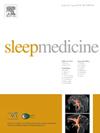Beyond bedwetting: How successful treatment is observed in sleep macrostructure
IF 3.8
2区 医学
Q1 CLINICAL NEUROLOGY
引用次数: 0
Abstract
Introduction
Sleep enuresis (SE), commonly known as bedwetting, refers to involuntary urination during sleep. It is a prevalent condition affecting approximately 15 % of children at age 5, 10 % by age 7, and 5 % by age 10. This condition can significantly impact both children and their families. The pathophysiology of SE is complex and not yet fully understood. There are several established treatment methods, but limited information on their sleep dynamics.
Objective
This study aimed to evaluate differences in sleep structure before and after treatment in patients with monosymptomatic SE (MSE), focusing on alarm therapy, desmopressin, and a combination of both. The analysis compared pre- and post-treatment differences within each treatment arm. The analysis was conducted for both successful and unsuccessful treatment outcomes.
Methods/results
This was a prospective study with MSE patients, aged 6–16 years, diagnosed by multidisciplinary assessment. Of the 140 initial applicants 75 were initially included in the study and randomized for therapeutic intervention in three treatment arms, namely: alarm, desmopressin and alarm + desmopressin. Therapeutic response was evaluated 12 months after treatment discontinuation. Polysomnographic evaluation pre and post treatment was carried out. 51/75 completed the entire protocol. 42/51 were successfully treated and had a median age of 10 [8–12] and the non-success, 8 [7–10]. Among the successful patients, the percentage of N2 sleep decreased from a median of 55.7 %–48.5 % (p = 0.0004) in the alarm arm, from 58.8 % to 50 % (p = 0.002) in the desmopressin arm, and from 54.7 % to 50.9 % (p = 0.044) in the combined arm. The percentage of N3 sleep increased from 25.7 % to 30.1 % (p = 0.004) in the alarm arm, from 21.6 % to 26 % (p = 0.032) in the desmopressin arm, and from 23.7 % to 28.3 % (p = 0.014) in the combined arm. The arousal index significantly increased from pre-to post-treatment in all arms: in the alarm arm, from 1.25 to 2.8 (p = 0.002); in the desmopressin arm, from 1.3 to 2.7 (p = 0.019); and in the combined treatment arm, from 1 to 4 (p = 0.003). No significant differences were observed in the non-successful arm or among those who experienced complete resolution of the enuresis without treatment.
Conclusion
The observed increase in N3 sleep and arousal and decrease in N2 sleep following successful treatment, regardless of the specific interventions, underscores the role of sleep in the pathophysiology of enuresis. Conversely, the lack of sleep differences in the non-successful arm further highlights the importance of sleep, beyond developmental factors, in influencing the clinical outcomes of enuresis, especially since all children were assessed 12 months after the start of treatment.
尿床之外:如何在睡眠宏观结构中观察成功治疗。
导言:遗尿症(SE)俗称尿床,是指睡眠时不自主地排尿。这是一种常见疾病,5 岁儿童中约有 15%、7 岁儿童中约有 10%、10 岁儿童中约有 5%。这种情况会对儿童及其家庭造成严重影响。SE 的病理生理学非常复杂,目前尚未完全明了。目前已有几种成熟的治疗方法,但有关其睡眠动态的信息却很有限:本研究旨在评估单症状 SE(MSE)患者在治疗前后睡眠结构的差异,重点关注警报疗法、去氨加压素以及两者的结合。分析比较了各治疗组治疗前后的差异。方法/结果:这是一项前瞻性研究,对象是经多学科评估确诊的 6-16 岁 MSE 患者。在最初申请的 140 人中,有 75 人被纳入研究,并被随机分为三个治疗组进行治疗干预,即:警报器、去氨加压素和警报器 + 去氨加压素。在停止治疗 12 个月后对治疗反应进行评估。治疗前后均进行了多导睡眠图评估。51/75的患者完成了整个治疗方案。其中 42/51 例治疗成功,中位年龄为 10 岁 [8-12],未治疗成功的患者年龄为 8 岁 [7-10]。在治疗成功的患者中,警报治疗组的 N2 睡眠百分比从中位数 55.7% 降至 48.5%(p = 0.0004),去氨加压素治疗组从 58.8% 降至 50%(p = 0.002),联合治疗组从 54.7% 降至 50.9%(p = 0.044)。报警组的 N3 睡眠百分比从 25.7% 增加到 30.1% (p = 0.004),去氨加压素组从 21.6% 增加到 26% (p = 0.032),联合组从 23.7% 增加到 28.3% (p = 0.014)。所有治疗组的唤醒指数从治疗前到治疗后都有明显增加:警报治疗组从 1.25 增加到 2.8(p = 0.002);去氨加压素治疗组从 1.3 增加到 2.7(p = 0.019);联合治疗组从 1 增加到 4(p = 0.003)。在未成功治疗组或未经治疗完全消除遗尿症的患者中未观察到明显差异:结论:无论采取何种具体干预措施,治疗成功后观察到 N3 睡眠和唤醒增加,N2 睡眠减少,这强调了睡眠在遗尿症病理生理学中的作用。相反,未成功治疗组的睡眠差异不大,这进一步凸显了除发育因素外,睡眠在影响遗尿症临床结果方面的重要性,尤其是所有患儿都是在治疗开始 12 个月后接受评估的。
本文章由计算机程序翻译,如有差异,请以英文原文为准。
求助全文
约1分钟内获得全文
求助全文
来源期刊

Sleep medicine
医学-临床神经学
CiteScore
8.40
自引率
6.20%
发文量
1060
审稿时长
49 days
期刊介绍:
Sleep Medicine aims to be a journal no one involved in clinical sleep medicine can do without.
A journal primarily focussing on the human aspects of sleep, integrating the various disciplines that are involved in sleep medicine: neurology, clinical neurophysiology, internal medicine (particularly pulmonology and cardiology), psychology, psychiatry, sleep technology, pediatrics, neurosurgery, otorhinolaryngology, and dentistry.
The journal publishes the following types of articles: Reviews (also intended as a way to bridge the gap between basic sleep research and clinical relevance); Original Research Articles; Full-length articles; Brief communications; Controversies; Case reports; Letters to the Editor; Journal search and commentaries; Book reviews; Meeting announcements; Listing of relevant organisations plus web sites.
 求助内容:
求助内容: 应助结果提醒方式:
应助结果提醒方式:


